
 |
|
|
1. Flooring Tools |
Top of Page |
|
|
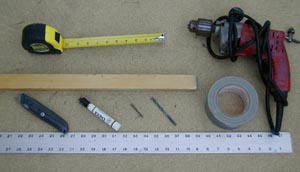
|
|
2. Selecting Carpet |
Top of Page |
|
|
(1) Used carpet can often be found in dumpsters, carpeting stores or at building sites where renovation is being done. (2) When hunting for carpet bring a utility knife, a tape measure and a roll of duct tape. (3) The optimum diameter is 12' 7 1/8". We have not had much luck finding anything suitable in this size and instead have resorted to using two or three pieces of same-color, same-nap carpet to create a single carpet for a dome. (4) Check any prospective carpet for stains, cuts, holes and tears. |
|
3. Measuring and Cutting Carpet |
Top of Page |
|
|
(1) Lay out the carpet on a flat surface with the nap side facing downward. If you are making it from several pieces, abut the pieces together to form a surface big enough to incorporate a circle 12' 7 1/8" in diameter, as in the picture opposite. The circle will eventually be cut into a ten-sided polygon shape, known as a decagon, with a radius of 6' 3 9/16". Note that at this stage the separate pieces do not need to be taped together.
|
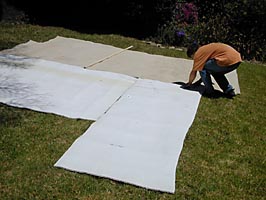
|
|
|
(2) Draw a circle on the carpet with a compass. (3) To make the compass use a 1" x 2" x 8' piece of wood (we have tried using a pen with string attached but found it too inaccurate). (4) Measure 1" in from one end of the 1" x 2" and screw a 1 5/8" drywall screw through the center of the wood. This will act as the central rotating point of the compass. (5) Next measure 75 9/16" from the screw and mark it. (6) Drill a hole in the center of the mark big enough to allow a marker tip to protrude through to the other side. Your compass should now look like the one in the diagram opposite. |
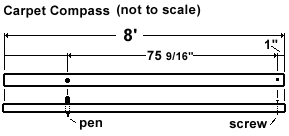 |
|
|
(7) Screw the central rotating point through the central point on the carpet and draw out a circle. |
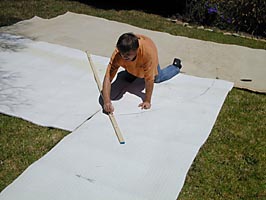 |
|
|
(8) Use the circle as a reference to draw the decagon. Mark a starting point on the circle line. From that point, measure a line 46 11/16" across the inside of the circle. Mark the precise point where that line touches the circle line. You now have two points that demarcate the first decagon side. Repeat the process from the second point until you have all ten marks (see diagram opposite). Note: Once you have successfully marked all ten points, you may wish to draw the lines from point to point to visually form the decagon. (9) If your last measurement went past the original mark, measure how many inches you went past, divide that by ten and reduce the measurement on the straight edge by that amount and remark all the points. Conversely, if you were short, measure the distance of the short-coming, divide by ten and add that number to the measurement on the straight edge. If you are off by more than 3", you may have to remeasure the radius of the circle or double check the measurement on the straight edge. (10) To cut the carpet, align the straight edge from one point to another, hold the it firmly in place and make the cut. (11) Make the cuts all the way around the circle until you have a decagon. |
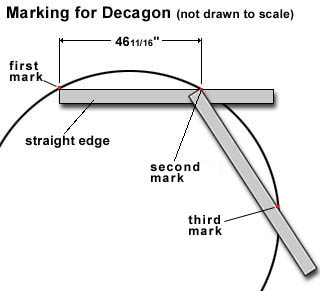 |
|
4. Taping Carpet |
Top of Page |
|
|
(1) If the carpet is whole and in one piece, duct tape around the outer edge to keep the carpet from fraying (2) If the carpet is made from two or three pieces, duct tape the outer edge of each individual piece. Spread the pieces out in order, nap side down, abut them against each other,then duct tape them together along their seams. Taping each seam with three overlapping pieces of tape is recommended. (3) If you wish to make the seams stronger apply foot long pieces of duct tape perpendicular to the seam with a piece of tape every eight inches or so. |
|
5. Making a Plastic Ground Cloth |
Top of Page |
|
|
(1) To help keep moisture out in the event of rain storm use thick plastic sheeting as a ground cloth under the carpet. (2) The plastic should be 4 mil thick. A roll of it can generally be bought at any paint or hardware store. Try to find plastic that is over 14 feet in width. If you are unable to find the right size plastic duct tape two pieces together. (3) Unroll the plastic on a flat surface. Cut a square 14' x 14'. Cutting the plastic to the shape of the dome takes place after the dome has been assembled. |